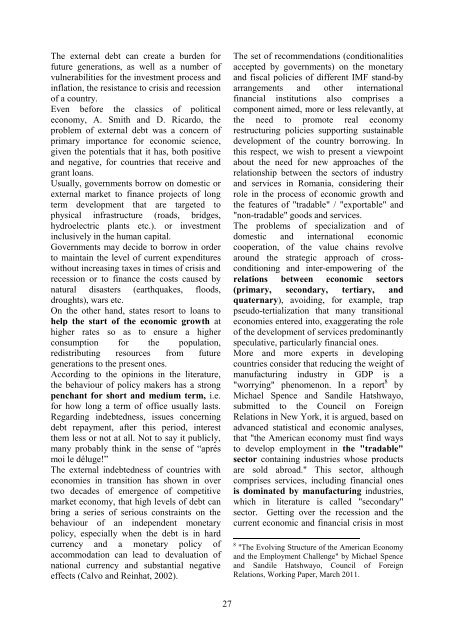Selected papers~ SPECIAL EDITION - Index of
Selected papers~ SPECIAL EDITION - Index of
Selected papers~ SPECIAL EDITION - Index of
You also want an ePaper? Increase the reach of your titles
YUMPU automatically turns print PDFs into web optimized ePapers that Google loves.
The external debt can create a burden for<br />
future generations, as well as a number <strong>of</strong><br />
vulnerabilities for the investment process and<br />
inflation, the resistance to crisis and recession<br />
<strong>of</strong> a country.<br />
Even before the classics <strong>of</strong> political<br />
economy, A. Smith and D. Ricardo, the<br />
problem <strong>of</strong> external debt was a concern <strong>of</strong><br />
primary importance for economic science,<br />
given the potentials that it has, both positive<br />
and negative, for countries that receive and<br />
grant loans.<br />
Usually, governments borrow on domestic or<br />
external market to finance projects <strong>of</strong> long<br />
term development that are targeted to<br />
physical infrastructure (roads, bridges,<br />
hydroelectric plants etc.). or investment<br />
inclusively in the human capital.<br />
Governments may decide to borrow in order<br />
to maintain the level <strong>of</strong> current expenditures<br />
without increasing taxes in times <strong>of</strong> crisis and<br />
recession or to finance the costs caused by<br />
natural disasters (earthquakes, floods,<br />
droughts), wars etc.<br />
On the other hand, states resort to loans to<br />
help the start <strong>of</strong> the economic growth at<br />
higher rates so as to ensure a higher<br />
consumption for the population,<br />
redistributing resources from future<br />
generations to the present ones.<br />
According to the opinions in the literature,<br />
the behaviour <strong>of</strong> policy makers has a strong<br />
penchant for short and medium term, i.e.<br />
for how long a term <strong>of</strong> <strong>of</strong>fice usually lasts.<br />
Regarding indebtedness, issues concerning<br />
debt repayment, after this period, interest<br />
them less or not at all. Not to say it publicly,<br />
many probably think in the sense <strong>of</strong> “aprés<br />
moi le déluge!”<br />
The external indebtedness <strong>of</strong> countries with<br />
economies in transition has shown in over<br />
two decades <strong>of</strong> emergence <strong>of</strong> competitive<br />
market economy, that high levels <strong>of</strong> debt can<br />
bring a series <strong>of</strong> serious constraints on the<br />
behaviour <strong>of</strong> an independent monetary<br />
policy, especially when the debt is in hard<br />
currency and a monetary policy <strong>of</strong><br />
accommodation can lead to devaluation <strong>of</strong><br />
national currency and substantial negative<br />
effects (Calvo and Reinhat, 2002).<br />
27<br />
The set <strong>of</strong> recommendations (conditionalities<br />
accepted by governments) on the monetary<br />
and fiscal policies <strong>of</strong> different IMF stand-by<br />
arrangements and other international<br />
financial institutions also comprises a<br />
component aimed, more or less relevantly, at<br />
the need to promote real economy<br />
restructuring policies supporting sustainable<br />
development <strong>of</strong> the country borrowing. In<br />
this respect, we wish to present a viewpoint<br />
about the need for new approaches <strong>of</strong> the<br />
relationship between the sectors <strong>of</strong> industry<br />
and services in Romania, considering their<br />
role in the process <strong>of</strong> economic growth and<br />
the features <strong>of</strong> "tradable" / "exportable" and<br />
"non-tradable" goods and services.<br />
The problems <strong>of</strong> specialization and <strong>of</strong><br />
domestic and international economic<br />
cooperation, <strong>of</strong> the value chains revolve<br />
around the strategic approach <strong>of</strong> crossconditioning<br />
and inter-empowering <strong>of</strong> the<br />
relations between economic sectors<br />
(primary, secondary, tertiary, and<br />
quaternary), avoiding, for example, trap<br />
pseudo-tertialization that many transitional<br />
economies entered into, exaggerating the role<br />
<strong>of</strong> the development <strong>of</strong> services predominantly<br />
speculative, particularly financial ones.<br />
More and more experts in developing<br />
countries consider that reducing the weight <strong>of</strong><br />
manufacturing industry in GDP is a<br />
"worrying" phenomenon. In a report 8 by<br />
Michael Spence and Sandile Hatshwayo,<br />
submitted to the Council on Foreign<br />
Relations in New York, it is argued, based on<br />
advanced statistical and economic analyses,<br />
that "the American economy must find ways<br />
to develop employment in the "tradable"<br />
sector containing industries whose products<br />
are sold abroad." This sector, although<br />
comprises services, including financial ones<br />
is dominated by manufacturing industries,<br />
which in literature is called "secondary"<br />
sector. Getting over the recession and the<br />
current economic and financial crisis in most<br />
8 "The Evolving Structure <strong>of</strong> the American Economy<br />
and the Employment Challenge" by Michael Spence<br />
and Sandile Hatshwayo, Council <strong>of</strong> Foreign<br />
Relations, Working Paper, March 2011.


